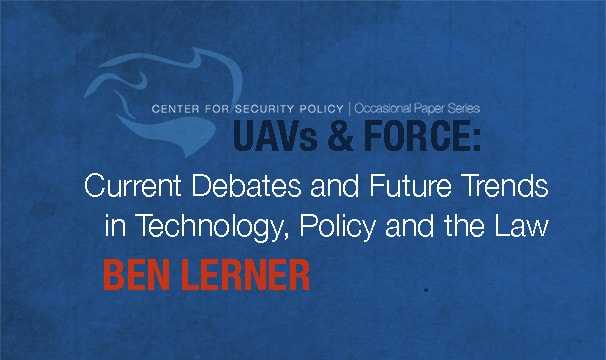UAVs and Force: Current Debates and Future Trends in Technology, Policy and the Law
The ongoing legal and policy debates surrounding the use of UAVs to support or undertake lethal force abroad.

 This study examines a representative sample of the ongoing legal and policy debates surrounding the United States’ use of unmanned aerial vehicles (UAVs) to support or undertake lethal force abroad, particularly with respect to the surveillance and targeting of non-state asymmetric actors. The study also explores technological trends in the development of UAVs for purposes of undertaking force or force-supporting missions, as well as the trajectory of legal and policy developments in response to the use of UAVs, including possible policy consequences of further restricting the use of such platforms.
This study examines a representative sample of the ongoing legal and policy debates surrounding the United States’ use of unmanned aerial vehicles (UAVs) to support or undertake lethal force abroad, particularly with respect to the surveillance and targeting of non-state asymmetric actors. The study also explores technological trends in the development of UAVs for purposes of undertaking force or force-supporting missions, as well as the trajectory of legal and policy developments in response to the use of UAVs, including possible policy consequences of further restricting the use of such platforms.The commentary contained throughout the study is derived in part from interviews with primary sources—drawn from leading think tanks, human rights organizations, technology companies, and academia—representing a range of opinions on the technological feasibility, legality, and policy advisability of deploying UAVs for lethal force purposes. The study also draws extensively on secondary research on these same questions, from sources across the opinion spectrum.
The study finds that there are significant trends taking place in the development of UAV technology relevant to their use for intelligence-surveillance-reconnaissance (ISR) purposes in support of lethal force, and for the exercise of lethal force itself. The technology trends identified through primary source interviews and secondary source analysis include: [1] a continuing demand for, and development of, UAVs for Intelligence, Surveillance and Reconnaissance (ISR) and munitions deployment purposes; [2] the extension of the geographic range of UAVs, particularly in the context of their use aboard aircraft carriers, although obstacles may remain with respect to trade-space issues surrounding payload vs. endurance; [3] UAV designs incorporating greater levels of autonomy, requiring less direct remote piloting by humans; [4] increasing precision and maneuverability, through innovations such as smaller, lighter-weight UAVs with correspondingly smaller munitions, as well as interest in the use of directed energy as part of the UAV platform; and [5] increasing proliferation of UAV technology to both state and non-state actors, with potential for “dual-use” capabilities between ISR and weapons deployment.
Read the paper at the link below.
![]() Ben Lerner: UAVs and Force: Current Debates and Future Trends in Technology, Policy and the Law | Center for Security Policy Occasional Paper Series | October 23, 2013 (PDF 104 pages, 2.6MB) | Executive Summary | October 23, 2013 (PDF, 6 pages, 153KB)
Ben Lerner: UAVs and Force: Current Debates and Future Trends in Technology, Policy and the Law | Center for Security Policy Occasional Paper Series | October 23, 2013 (PDF 104 pages, 2.6MB) | Executive Summary | October 23, 2013 (PDF, 6 pages, 153KB)
- Trump’s Election Was a Win in the Fight to Keep Gitmo Open - January 4, 2017
- NDAA and the Counter-Drone Challenge - December 23, 2016
- NDAA Takes On Counter-Drone Challenge - December 8, 2016
